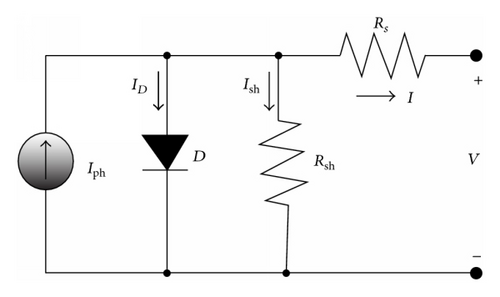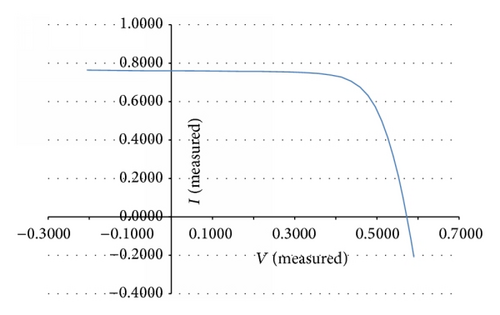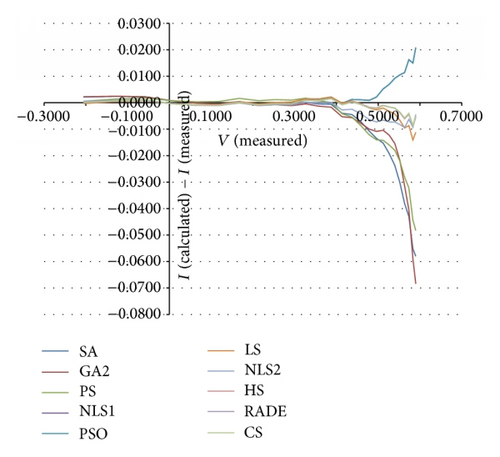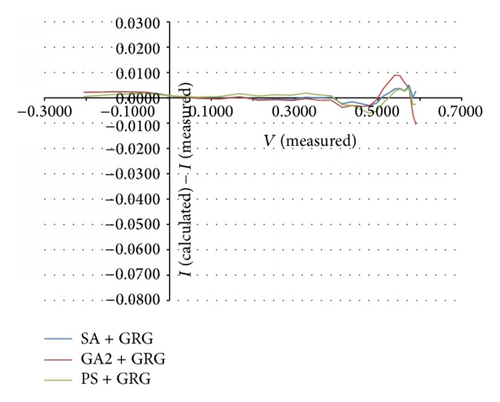Parameter Optimization of Single-Diode Model of Photovoltaic Cell Using Memetic Algorithm
Abstract
This study proposes a memetic approach for optimally determining the parameter values of single-diode-equivalent solar cell model. The memetic algorithm, which combines metaheuristic and gradient-based techniques, has the merit of good performance in both global and local searches. First, 10 single algorithms were considered including genetic algorithm, simulated annealing, particle swarm optimization, harmony search, differential evolution, cuckoo search, least squares method, and pattern search; then their final solutions were used as initial vectors for generalized reduced gradient technique. From this memetic approach, we could further improve the accuracy of the estimated solar cell parameters when compared with single algorithm approaches.
1. Introduction
Determining the parameter values of photovoltaic (PV) cell models is very important when designing solar cells and estimating their performance. The key parameters that represent the behavior of solar cells include generated photocurrent, saturation current, series resistance, shunt resistance, and ideality factor [1]. Estimating these parameters accurately is essential for precise modeling and accurate performance evaluation of solar cells.
Several models have been proposed to describe the behavior of solar cells using current-voltage (I-V) relationship [2–4]. The I-V curve of a solar cell has nonlinear characteristics determined by the solar cell parameters. These models generally consist of analytical equations based on a physical description that formulate PV-generated current with the technical characteristics and the environmental variables including the operating voltage, the ambient temperature, and the irradiance [5]. Among numerous modeling approaches, the single-diode model (SDM) is the most widely utilized solar cell model in the literature. A general SDM includes five parameters: photocurrent, saturation current, diode ideality constant, series resistance, and shunt resistance.
So far various computational intelligence methods, such as genetic algorithm, particle swarm optimization, simulated annealing, and harmony search, have been proposed for optimal estimation of solar cell parameters. Many studies have aimed to overcome the shortcomings of the conventional deterministic algorithms and to investigate the efficiency and applicability of the algorithms. Hybrid methods combining two or more metaheuristic algorithms also have been applied to explore the capability of stochastic artificial intelligence algorithms in estimating solar cell parameters. These algorithms could find relevant parameter values by minimizing the root mean square error (RMSE) as the objective function in the optimization process.
Up to now, metaheuristic algorithms have shown a higher level of applicability in estimating solar cell parameters with fine performance. Nonetheless, we also presume that a memetic approach, which combines the well-developed evolutionary frameworks with gradient-based local search algorithm, can provide an opportunity for better solutions. Through this memetic combination, it can be seen that the accuracy represented by RMSE can be further improved because metaheuristic algorithm can be reinforced by calculus-based method in terms of local search performance and calculus-based method can be reinforced by metaheuristic algorithm in terms of global search performance.
This paper is organized as follows. Optimization formulation of the problem to determine the solar cell parameters is described in Section 2. In Section 3, a memetic implementation, which integrates gradient-based local search into the evolutionary frameworks for better determining the parameters, is described. Then, simulation results of the proposed approach are provided in Section 4, followed by conclusions in Section 5.
2. Optimization Formulation of Photovoltaic Model

| V | I | Algorithm | |||||||||
|---|---|---|---|---|---|---|---|---|---|---|---|
| SA | GA2 | PS | NLS1 | PSO | LS | NLS2 | HS | RADE | CS | ||
| −0.2057 | 0.7640 | 0.7662 | 0.7662 | 0.7645 | 0.7641 | 0.7641 | 0.7637 | 0.7645 | 0.7640 | 0.7641 | 0.7641 |
| −0.1291 | 0.7620 | 0.7644 | 0.7644 | 0.7633 | 0.7627 | 0.7627 | 0.7624 | 0.7629 | 0.7626 | 0.7627 | 0.7627 |
| −0.0588 | 0.7605 | 0.7628 | 0.7628 | 0.7622 | 0.7614 | 0.7614 | 0.7612 | 0.7615 | 0.7613 | 0.7614 | 0.7614 |
| 0.0057 | 0.7605 | 0.7613 | 0.7612 | 0.7612 | 0.7602 | 0.7602 | 0.7601 | 0.7602 | 0.7601 | 0.7602 | 0.7602 |
| 0.0646 | 0.7600 | 0.7599 | 0.7598 | 0.7603 | 0.7591 | 0.7591 | 0.7592 | 0.7590 | 0.7590 | 0.7591 | 0.7591 |
| 0.1185 | 0.7590 | 0.7586 | 0.7585 | 0.7595 | 0.7581 | 0.7581 | 0.7583 | 0.7579 | 0.7580 | 0.7580 | 0.7581 |
| 0.1678 | 0.7570 | 0.7574 | 0.7573 | 0.7586 | 0.7571 | 0.7571 | 0.7574 | 0.7569 | 0.7570 | 0.7571 | 0.7571 |
| 0.2132 | 0.7570 | 0.7563 | 0.7561 | 0.7577 | 0.7562 | 0.7562 | 0.7565 | 0.7559 | 0.7561 | 0.7561 | 0.7562 |
| 0.2545 | 0.7555 | 0.7550 | 0.7547 | 0.7566 | 0.7551 | 0.7551 | 0.7556 | 0.7547 | 0.7550 | 0.7551 | 0.7551 |
| 0.2924 | 0.7540 | 0.7532 | 0.7529 | 0.7550 | 0.7537 | 0.7537 | 0.7542 | 0.7532 | 0.7536 | 0.7537 | 0.7537 |
| 0.3269 | 0.7505 | 0.7506 | 0.7500 | 0.7522 | 0.7515 | 0.7515 | 0.7520 | 0.7507 | 0.7513 | 0.7514 | 0.7514 |
| 0.3585 | 0.7465 | 0.7460 | 0.7452 | 0.7472 | 0.7475 | 0.7475 | 0.7480 | 0.7463 | 0.7473 | 0.7473 | 0.7473 |
| 0.3873 | 0.7385 | 0.7379 | 0.7368 | 0.7386 | 0.7403 | 0.7403 | 0.7407 | 0.7387 | 0.7401 | 0.7401 | 0.7401 |
| 0.4137 | 0.7280 | 0.7240 | 0.7227 | 0.7238 | 0.7278 | 0.7278 | 0.7278 | 0.7253 | 0.7274 | 0.7272 | 0.7273 |
| 0.4373 | 0.7065 | 0.7020 | 0.7008 | 0.7011 | 0.7077 | 0.7077 | 0.7072 | 0.7040 | 0.7069 | 0.7067 | 0.7067 |
| 0.4590 | 0.6755 | 0.6683 | 0.6677 | 0.6668 | 0.6766 | 0.6766 | 0.6751 | 0.6713 | 0.6751 | 0.6748 | 0.6748 |
| 0.4784 | 0.6320 | 0.6213 | 0.6220 | 0.6199 | 0.6329 | 0.6328 | 0.6299 | 0.6256 | 0.6303 | 0.6300 | 0.6300 |
| 0.4960 | 0.5730 | 0.5595 | 0.5622 | 0.5590 | 0.5751 | 0.5751 | 0.5703 | 0.5657 | 0.5710 | 0.5708 | 0.5708 |
| 0.5119 | 0.4990 | 0.4838 | 0.4886 | 0.4848 | 0.5042 | 0.5042 | 0.4969 | 0.4924 | 0.4981 | 0.4979 | 0.4979 |
| 0.5265 | 0.4130 | 0.3937 | 0.4007 | 0.3970 | 0.4199 | 0.4199 | 0.4098 | 0.4057 | 0.4114 | 0.4114 | 0.4114 |
| 0.5398 | 0.3165 | 0.2928 | 0.3011 | 0.2985 | 0.3257 | 0.3257 | 0.3122 | 0.3092 | 0.3144 | 0.3145 | 0.3145 |
| 0.5521 | 0.2120 | 0.1818 | 0.1902 | 0.1899 | 0.2225 | 0.2225 | 0.2054 | 0.2038 | 0.2082 | 0.2084 | 0.2084 |
| 0.5633 | 0.1035 | 0.0654 | 0.0721 | 0.0754 | 0.1149 | 0.1148 | 0.0939 | 0.0941 | 0.0974 | 0.0976 | 0.0978 |
| 0.5736 | −0.0100 | −0.0529 | −0.0504 | −0.0422 | 0.0063 | 0.0062 | −0.0186 | −0.0163 | −0.0144 | −0.0142 | −0.0140 |
| 0.5833 | −0.1230 | −0.1782 | −0.1819 | −0.1673 | −0.1080 | −0.1081 | −0.1371 | −0.1323 | −0.1319 | −0.1319 | −0.1316 |
| 0.5900 | −0.2100 | −0.2680 | −0.2785 | −0.2583 | −0.1891 | −0.1893 | −0.2212 | −0.2145 | −0.2153 | −0.2155 | −0.2151 |
| RMSE | 0.02165 | 0.02158 | 0.01741 | 0.00719 | 0.00715 | 0.00477 | 0.00474 | 0.00280 | 0.00278 | 0.00269 | |

3. Memetic Implementation
Memetic computing is a branch in computer science which considers complicate structures as the combination of heterogeneous operators, named memes, whose evolutionary interactions contribute to intelligent structures for problem solving [10, 11]. For recent decades, memetic algorithms have been widely applied in the large-scale complex optimization problems.
The problem of balance between global and local search, that is, balance between computational intelligence and gradient-based search algorithm, has been explored under a multiobjective optimization setting in [12, 13]. In [14], a memetic algorithm was presented to analyze the evolutionary artificial neural network for training of a medical application. For a large-scale combinatorial optimization problem, a parallel memetic algorithm with selective local search was proposed in [15]. In [16–18], memetic algorithms were applied to solve scheduling and planning problems such as vehicle routing and path planning. A fast adaptive memetic algorithm for a design of controller of engineering drives was presented in [19], and a compact memetic differential algorithm has been developed for a robot control in [20]. In [21], a differential evolution-based hybrid algorithm was provided to solve the optimization problem in flow-dynamic design. In [22] a novel memetic algorithm scheme was proposed by combining metaheuristic algorithm and gradient-based technique to find better solutions for an economic load dispatch problem with valve-point loading.
In order to explore the opportunity of better solution in determining solar cell parameters using the memetic combination proposed in this study, various metaheuristic algorithms, such as genetic algorithm, simulated annealing, particle swarm optimization, harmony search, and cuckoo search, as well as mathematical approaches, such as least squares method and pattern search, have been performed, which have shown the good level of performances among all the existing relevant approaches in literature.
Once good parameter values for the PV cell model are obtained using the above-mentioned various algorithms, the values can be further polished using gradient-based techniques. In this study, we adopted generalized reduced gradient (GRG) method as the gradient-based local search technique.
4. Computational Results
For this PV parameter optimization problem, various metaheuristic and mathematical algorithms have so far proposed their solutions, as summarized in Table 2. As seen in Table 2, the obtained solution vector of PV model parameters from simulated annealing (SA) [26] made RMSE of 0.02165, which is the worst one among various solution vectors if outlier from genetic algorithm 1 (GA1) is not considered; genetic algorithm 2 (GA2) [27] produced RMSE of 0.02158, which is slightly better than SA; pattern search (PS) [28] produced RMSE of 0.01741; nonlinear least squares 1 (NLS1) [9] produced RMSE of 0.00719; particle swarm optimization (PSO) [4] produced RMSE of 0.00715; least squares (LS) method [29] produced RMSE of 0.00477; nonlinear least squares 2 (NLS2) [1] produced RMSE of 0.00474; harmony search (HS) [30] produced RMSE of 0.00280; repaired adaptive differential evolution (RADE) [31] produced RMSE of 0.00278; and cuckoo search (CS) [5] produced RMSE of 0.00269 which is the best one among algorithms. Ye et al. [4] proposed GA1, but it does not appear to be good because its RMSE is huge (132,590). Although there are two nonlinear least squares (NLS1 and NLS2) and two genetic algorithms (GA1 and GA2), they are different in terms of algorithm structure and algorithm parameter values.
| Parameter | Algorithm | ||||||||||
|---|---|---|---|---|---|---|---|---|---|---|---|
| SA | GA2 | PS | NLS1 | PSO | LS | NLS2 | HS | RADE | CS | GA1 | |
| Iph | 0.7620 | 0.7619 | 0.7617 | 0.7608 | 0.7608 | 0.7607 | 0.7609 | 0.7607 | 0.7608 | 0.7608 | 0.7756 |
| ISD | 4.8 × 10−7 | 8.1 × 10−7 | 10.0 × 10−7 | 3.2 × 10−7 | 3.2 × 10−7 | 3.3 × 10−7 | 4.0 × 10−7 | 3.0 × 10−7 | 3.2 × 10−7 | 3.2 × 10−7 | 5.6 × 10−7 |
| Rs | 0.0345 | 0.0299 | 0.0313 | 0.0364 | 0.0364 | 0.0364 | 0.0364 | 0.0366 | 0.0364 | 0.0364 | 0.0697 |
| Rsh | 43.103 | 42.373 | 64.103 | 53.763 | 53.796 | 60.241 | 49.505 | 53.595 | 53.7185 | 53.7185 | 10.084 |
| n | 1.5172 | 1.5751 | 1.6000 | 1.4837 | 1.4838 | 1.4816 | 1.5039 | 1.4754 | 1.4812 | 1.4812 | 0.8053 |
| RMSE | 0.02165 | 0.02158 | 0.01741 | 0.00719 | 0.00715 | 0.00477 | 0.00474 | 0.00280 | 0.00278 | 0.00269 | 132590 |
The search range of decision variable is Iph = [0,1], ISD = [0,1e − 6], Rs = [0,0.5], Rsh = [0,100], and n = [1,2] [30], and several metaheuristic algorithms such as HS, RADE, and CS provided a number of function evaluations (HS = 5,000; RADE = 10,000; and CS = 5,000) while PSO provided time taken (242 seconds) and SA and GA2 did not mention any.
Table 1 shows corresponding currents calculated by various algorithms, and Figure 3 shows the errors between calculated and measured currents from various algorithms. As observed in the figure, the magnitude of the errors abruptly increases after around 0.4 V. Presumably this is because representing rapid change is more difficult than representing monotonic change. The measured current abruptly drops after around 0.4 V as seen in Figure 2.

The above-enumerated algorithms found good PV parameter values with small RMSE. However, is it possible to further improve the solution quality? The memetic algorithm, which combines metaheuristic and gradient-based algorithms, may answer to this question because the memetic algorithm can complement the weakness of metaheuristic algorithm by using gradient-based algorithm. Thus, we can obtain even better solutions if we introduce gradient-based algorithm to the metaheuristic algorithm.
The gradient-based algorithm (GRG in this study) by itself cannot find good solution unless it starts with good and feasible initial vector. Otherwise, it will get stuck in a local optimum or will diverge instead of converging.
For this PV parameter optimization problem also, finding good solutions using gradient-based algorithm requires proper feasible initial vector, which is not very easy and tedious task. Thus, the result vectors from metaheuristic or other mathematical algorithms can be used as the proper initial vectors for the gradient-based algorithm.
The results from the memetic approach were tabulated in Table 3. As seen in the table, some initial vectors could be further improved while others could not because of getting stuck in local optimal (LO). SA + GRG could improve RMSE from 0.02165 to 0.00209; GA2 + GRG could improve RMSE from 0.02158 to 0.00432; PS + GRG could improve RMSE from 0.01741 to 0.00261; however, NLS1 + GRG, PSO + GRG, LS + GRG, NLS2 + GRG, HS + GRG, RADE + GRG, and CS + GRG could not improve RMSE any further because they already reached local optima where there is no room to escape using the local search technique. Here, the computation time of GRG part is less than one second, so it does not become a burden.
| Parameter | Algorithm | |||||||||
|---|---|---|---|---|---|---|---|---|---|---|
SA + GRG |
GA2 + GRG |
PS + GRG |
NLS1 + GRG | PSO + GRG | LS + GRG | NLS2 + GRG | HS + GRG | RADE + GRG | CS + GRG | |
| Iph | 0.7620 | 0.7619 | 0.7617 | LO | LO | LO | LO | LO | LO | LO |
| ISD | 4.5 × 10−7 | 7.6 × 10−7 | 9.5 × 10−7 | |||||||
| Rs | 0.0345 | 0.0301 | 0.0313 | |||||||
| Rsh | 43.103 | 42.373 | 64.103 | |||||||
| n | 1.5172 | 1.5749 | 1.6000 | |||||||
| RMSE | 0.00209 | 0.00432 | 0.00261 | |||||||
Figure 4 shows the errors between calculated and measured currents from various memetic approaches. As observed in the figure, the magnitude of the errors is less than single algorithm approach. While CS found the best RMSE of 0.00269 in single algorithm approach, PS + GRG could find the better RMSE of 0.00261, and SA + GRG could find even better RMSE of 0.00209.

While the above approach used the constant ambient temperature (306°K or 32.85°C), the sensitivity of the ambient temperature was also tested under various operation (weather) conditions between −5°C and 40°C. SA + GRG produced the computation results as shown in Table 4. As seen in the table, Iph and Rs are fluctuating, ISD is increasing, n is decreasing, and Rsh is almost constant.
| Celsius (°C) | Kelvin (°K) | RMSE | Iph | ISD | Rs | Rsh | n |
|---|---|---|---|---|---|---|---|
| −5 | 268.15 | 0.01438 | 0.7776 | 1.72E − 07 | 0.0397 | 43.1035 | 1.6201 |
| 0 | 273.15 | 0.01658 | 0.7509 | 2.37E − 07 | 0.0293 | 43.1034 | 1.6310 |
| 5 | 278.15 | 0.00520 | 0.7666 | 2.05E − 07 | 0.0400 | 43.1033 | 1.5808 |
| 10 | 283.15 | 0.01107 | 0.7756 | 2.78E − 07 | 0.0400 | 43.1033 | 1.5837 |
| 15 | 288.15 | 0.01454 | 0.7802 | 2.93E − 07 | 0.0403 | 43.1032 | 1.5610 |
| 20 | 293.15 | 0.01952 | 0.7620 | 2.30E − 07 | 0.0345 | 43.1034 | 1.5172 |
| 25 | 298.15 | 0.00391 | 0.7620 | 3.10E − 07 | 0.0345 | 43.1034 | 1.5172 |
| 30 | 303.15 | 0.00203 | 0.7620 | 3.96E − 07 | 0.0345 | 43.1034 | 1.5172 |
| 35 | 308.15 | 0.01491 | 0.7620 | 4.80E − 07 | 0.0345 | 43.1034 | 1.5172 |
| 40 | 313.15 | 0.00236 | 0.7626 | 6.27E − 07 | 0.0331 | 43.1034 | 1.5171 |
5. Conclusions
In this study, a memetic approach has proposed for optimally determining the parameter values of single-diode-equivalent solar cell model. The memetic approach considered various metaheuristic and mathematical algorithms and combined them with GRG technique. The results validated the performance of the memetic approach, which further improved the quality of solutions originally obtained by various algorithms.
The proposed memetic approach in this work can be also further applied to more complicated and realistic PV models with various module types [32] in the future. And theoretically the balance between global search and local search can be a good future research topic because too much exploited solutions do not appear to be good initial vectors for local search algorithms. In addition, parameter-setting-free technique [33, 34] can be also incorporated in metaheuristic approach in order to eliminate tedious algorithm parameter setting task.
Nomenclature
-
- I:
-
- Observed terminal current
-
- ID:
-
- Diode current
-
- Iph:
-
- Cell-generated photocurrent
-
- ISD:
-
- Diode saturation current
-
- Ish:
-
- Shunt current
-
- k:
-
- Boltzmann constant (1.380650 × 10−23 J/K)
-
- n:
-
- Diode ideality factor
-
- q:
-
- Electron charge (1.602176 × 10−19 C)
-
- Rs:
-
- Series resistance
-
- Rsh:
-
- Shunt resistance
-
- T:
-
- Ambient temperature (306 K in this study)
-
- V:
-
- Observed operation voltage
-
- Vd:
-
- Electrical potential difference between both ends of the diode
-
- Vt:
-
- Thermal voltage.
Conflict of Interests
The authors declare that there is no conflict of interests regarding the publication of this paper.
Acknowledgment
This research was supported by the Gachon University research fund of 2015 (GCU-2015-0030).




